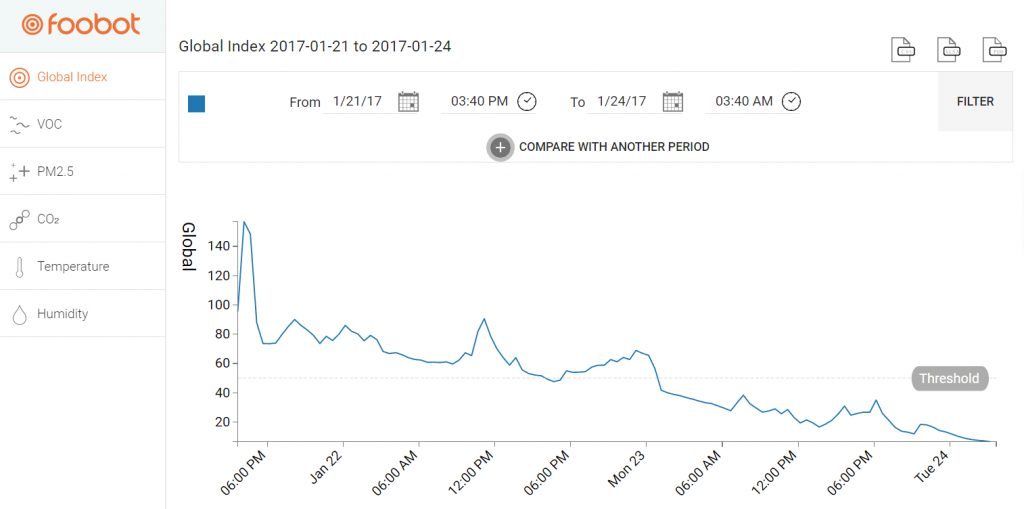An HVAC contractor or anyone else who works with a building’s air flow can easily add indoor air quality to their services. But what’s in it for them? How many houses really have serious IAQ issues? Furthermore, how many potential clients care enough about them to pay to get them fixed?
Both numbers are probably not as small as you think—sensor data shows 93% of homes have VOC issues and 67% have PM2.5 issues. But even if they were, new technology that’s already on the market is addressing both those issues at once. Contractors can now install a few gadgets to make a home automatically clean its air whenever pollution is present, a technique that’s now proven to greatly reduce the time an occupant spends in polluted air.
This is possible by combining a Foobot air quality monitor with a Nest learning thermostat. Foobot checks for VOCs and PM2.5s along with temperature and humidity, and Nest will switch on ventilation or activate smart gadgets like purifiers whenever a pollutant gets too high.
Foobot’s data scientists collected data from devices before and after they were connected to a Nest thermostat. The results are remarkable: On average, users spent 35.3 hours a week in air with unhealthy VOC levels. After adding a Nest thermostat to help automate the air quality, that number sank 33% down to just 23.7 hours. PM2.5s were even more impressive. Before, users would spend 28.4 hours a week in PM2.5-contaminated air. Afterward, it went down to just 13.3 hours – a 53% improvement.
While impressive, also keep in mind that these numbers came from any device where Nest integration was added after it had already been used. Where a professional contractor is involved, the effect is bound to be greater.
One such contractor having success with this is Don Ham of Refresh Smart Home. He and a group of friends started out as an inspections and testing firm, focused on helping homeowners optimize the quality of their indoor air. They have since transitioned to installing smart home products with its primary focus being on helping homeowners create smart and healthy homes.
To that end, Refresh was the first company to install what he calls the “trifecta” – a combination of a Nest thermostat, a Foobot and an IQAir purifier he integrates into a home’s central HVAC system. When Foobot detects pollution, the Nest thermostat will tell the central HVAC system to purify the air in the whole house.
The IAQ Dasboard, designed for HVAC Contractors, helps see the immediate implications of the work being done.
“Who would you say keeps you healthy?” Don asks. “Doctors are great when there’s already a problem, but they can’t be there for you all the time. To breathe cleaner air and stay healthy, you need ongoing protection. That’s what the trifecta does.”
As the average HVAC system for a home moves over 1,000 cubic feet of air per minute, and the IQAir purifier he uses has the highest grade filter available, Ham insists that having all three of these components is the only way to really protect the people in a building day-by-day. He says the change is so dramatic that you can literally see it: what little dust remains turns from dark to nearly white after he installs his trifecta.
The health results are even greater. He regularly installs it in the homes of allergy sufferers, who then report feeling no symptoms for the first time in years. For them, they understand the investment from the start, and the payoff changes their lives immediately after installation.
But for the business side of things, it’s important for Don that the problem is visible before the trifecta is switched on, so that he can convince them to buy one in the first place. As such, Foobot plays just as big of a role in selling the trifecta as it does in keeping it going. All his technicians now take Foobots with them at the start of a client relationship. By leaving one in a home, they can use the Foobot app to show them how much pollution is in their homes each day, so they can clearly see the otherwise invisible pollutants that are secretly impacting their lives.
“If they think of it as a cost, the trifecta won’t sell,” he says. “The Foobot helps show that it’s not an expense, but an investment. If you provide the facts, and show them that if they don’t invest in it now, they’ll pay for it later with their health, it becomes clear that investing in good air pays for itself many, many times over.”
Several times, when at apartments with small children, a technician would notice that the neighbors were smoking next door. Suddenly, they had a chance to make sure it was never a threat to their children—and they had the visual data to prove it. Moreover, the Nest system makes it easy to add additional standing purifiers to the mix for the children’s rooms, which Ham says is very important to add as people spend about a third of their days in the bedrooms.
“The greatest benefit of all is peace of mind,” says Don, who has the trifecta running in his own home despite not having any respiratory issues. Since so many pollutants do harm without any warning, having a way to constantly protect your home means a major health risk that you never have to worry about.
That’s why automated indoor air quality is great for everyone: it offers valuable business for HVAC contractors, by way of a service that makes an invaluable difference in people’s lives.
[thrive_leads id=’10821′]
Any thought about how Smart indoor air quality can change day-to-day HVAC activities? Join the discussion in the comments below.

